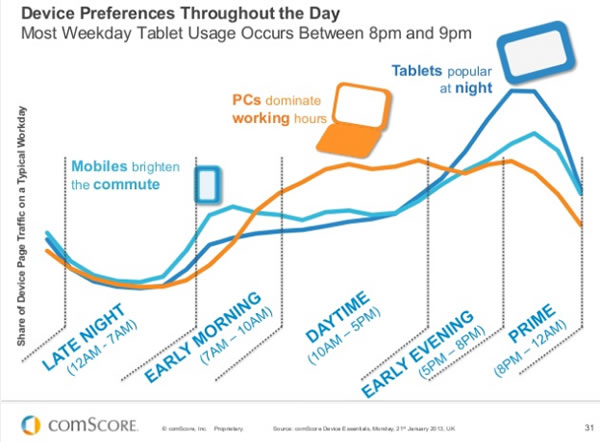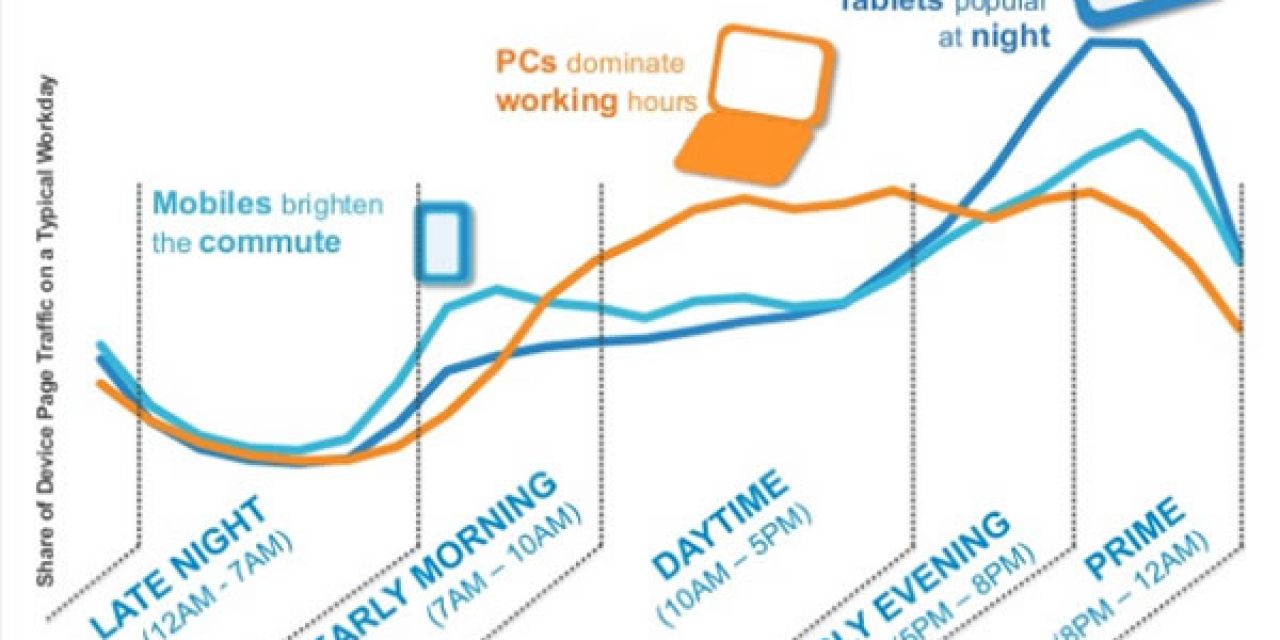Mobile content marketing. Or better: content marketing in a mobile context. It deserves your attention, regardless of the way you use content for several marketing and customer goals. Just look at all those evolutions in the mobile space and the impact they have on the behavior of your “audiences”, wearing supercomputers in their pockets, enabling them to have access to and interact with content at any time in any place.
Marketing TechBlog recently organized a webinar, in association with content marketing software platform Compendium and marketing automation firm ExactTarget. The topic: mobile content marketing. To generate attention for it, they used content, ‘noblesse oblige’ And as most of us love visual content one of the chosen content formats to promote it is the infographic below on the state of mobile content marketing.
The increasing adoption of mobile devices and technologies, deeply impacts consumer behavior and even the ways we work and do business (consumerization, collaboration, mobile CRM, etc.). I probably also don’t tell anything new when I say that the adoption of mobile devices and technologies is staggering. Data and research enough.
Research on mobile evolutions and mobile content consumption
There isn’t a single research firm that didn’t place the adoption of mobile devices and channels, as well as the activities we do on mobile and the time spent using mobile devices, high on their 2013 predictions and 2012 analysis lists. Just take the recent ‘Digital future in focus 2013‘ reports by comScore for instance. As an example, here are some key takeaways regarding mobile devices and activities in the US and the UK (quoting from the comScore reports).

Mobile in the UK
- The total UK mobile audience has grown to 49.5 million of which 31.7 million are on smartphones.
- More than 8 in 10 newly acquired devices are smartphones. Over 6 million Brits has a smartphone as well as a tablet in December 2012.
- Mobile and tablets are rapidly gaining on the PC for content consumption: nearly 1/3 of UK page views are from mobiles and tablets.
- The average time spent accessing the Internet via a mobile browser in the UK is now 9.5 hours per users a month.
- Mobile video has simply skyrocketed: there are 37.5 million online video viewers in the UK versus 11.2 million mobile video users.
- 1 in 5 Brits used their smartphone to purchase a good or service in December 2012 (are your sites and content adapted to convert better?).
I’m not going to cover all data. You find a lot more in the UK report, among others regarding preferred mobile activities, the device preferences throughout the day (very important), how brands adapt and much more.
Mobile in the US
Data for the US can be found in the report here. Some takeaways:
- By September 2012, there were more smartphone users than feature phone users for the first time in the US.
- Smartphone media usage is dominated by apps, which account for 4 out of every 5 minutes spent on smartphones with mobile web usage accounting for the remainder.
- 52.4 million Americans owned tablets by the end of 2012 and 28% of smartphone owners also have a tablet.
- Smartphones and tablets now drive 1 out of 3 minutes spent with digital media.
The numbers speak for themselves. Furthermore, it’s not just about mobile devices. No, we want multipurpose devices too, as ‘The 2013 Accenture Consumer Electronics Products and Services Usage Report‘ shows. At the same time we shouldn’t forget the basics. And, yes, SMS, is still used a lot too.
Finding mobile content priorities and opportunities in mobile usage patterns
What matters most to marketers though is what people do with these devices and from a ‘mobile content marketing’ perspective, how they ‘consume’ content, look for it and interact with it.
- What sorts of ‘mobile content’ are they looking for? Are you delivering it across mobile touchpoints?
- How do they buy using mobile devices, what makes them act?
- How does the different user experience between, for instance, tablets and smartphones, impact conversions?
- What are the favorite channels they use to inform themselves or interact using mobile devices?
- What about the impact of mobile on reading and sending email, browsing, social networking, sharing location, using apps, the preference and impact of the mobile Web over mobile apps, etc?
What works for one company never rarely works for another. If we look at the ‘mobile content marketing’ perspective we also see huge differences. Of course, it depends on our definition of content marketing, to start with.
However, no matter how you look at it: “mobile” to – once more use this very generic term – has an impact on how people ‘consume’ content, share content, find it, seek it, etc. It’s our job to make sure we act upon these insights, in alignment with our goals and potential new revenue models in some cases (remember the publishers, for instance) and increase existing revenue and service models (mobile commerce, to name just one example).
Different mobile content marketing priorities for different businesses
So, from a mobile content perspective there are different questions to answer. They depend on the industry, business, creativity and agility of our businesses on one hand and the goals and needs of the ‘mobile and connected consumer and business user’ on the other.
- It’s clear that publishers, for instance, look more at ways to monetize the content they already create for their print and online media, and present them in entirely new forms, supported by advertising revenues or paying models. Apps, anyone? In fact, in the talks I had in the last 2 years with C-level execs in the European media industries (all big international players), the attention for mobile by far outweighs their interest in social at this time. Traffic and eyeballs obviously also matter for publishers as most (online) advertising models are still mainly based on impressions and clicks.
- From other content marketing perspectives we have to pay more attention to enabling people to find us (by finding the content fulfilling their needs and wants), interact with us and so forth. Here as well, the user experience is essential: adapting email to mobile devices and mobile email ‘consumption’, mobile websites, mobile-friendly e-commerce or business interaction tools (e-banking), you name it.
It’s impossible to treat all content consumption and content marketing evolutions as a result of the mobile explosion, especially as content is used for so many different goals.
Key takeaways from MarketingTech Blog mobile usage data
To conclude, here are some takeaways of internal data analysis by MarketingTech Blog, Compendium and ExactTarget, from the blog post announcing the webinar and the infographic below:
- Open rates on mobile devices have increased by 300% from October 2010 to October 2012.
- Mobile email creates twice as many conversions as social activities or search.
- Mobile may not mean “on the go.” 51% of US mobile users browse, search, and purchase on mobile devices at home.
- Web visits on a mobile or tablet device are highest on Thursday at 15.7%.
- SMS marketing messaging is becoming more popular, with 31.2% of agencies using this tactic to increase click through.
What is your main content or content marketing challenge from a mobile perspective and how do your customers or target ‘audiences’ have changed their behavior as a result of ‘mobile’?
More in the infographic below.







